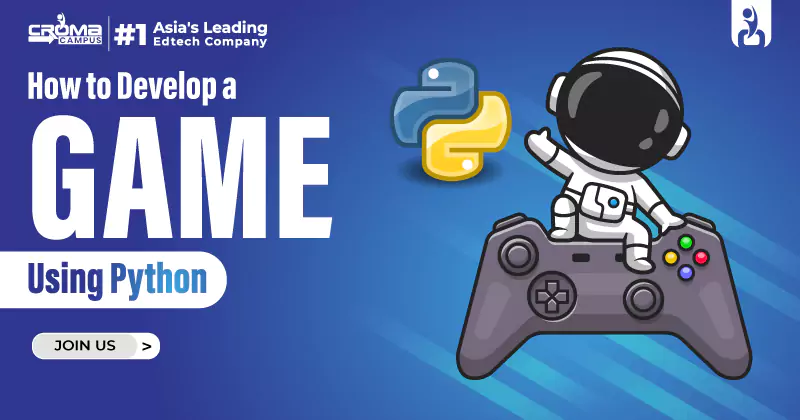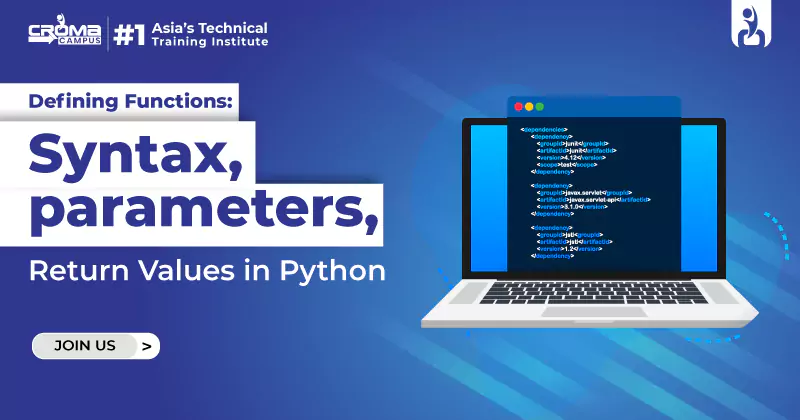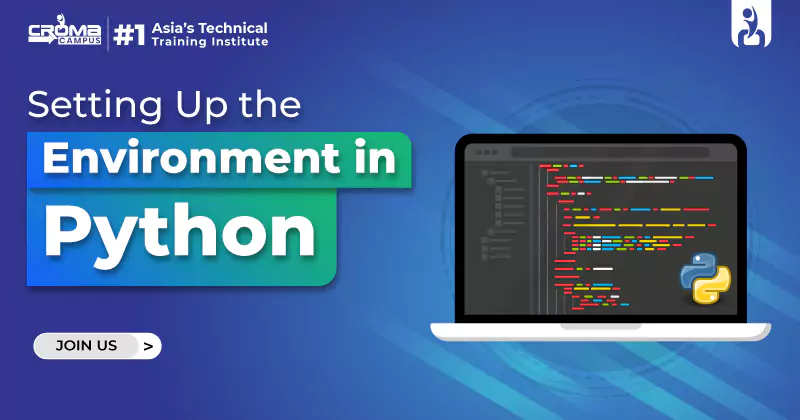How To Develop A Game Using Python: A Step-by-Step Guide?
4.9 out of 5 based on 15575 votesLast updated on 25th Mar 2025 20.2K Views
- Bookmark

Learn how to develop a game using Python with step-by-step guidance on game logic, graphics, and interactivity using libraries like Pygame.

Game development can sound like a daunting task, but with Python, it’s easier than you might think. Python is one of the most beginner-friendly programming languages and is perfect for creating simple games. Whether you're trying to create a game for fun, learning, or as a stepping stone to something bigger, Python can help you get started. If you're based in Delhi, you may want to consider taking a Python Course in Delhi to get hands-on experience in game development. Many courses focus on game-making, and learning locally gives you access to a vibrant tech community.
Why Python for Game Development?
Python is often known for its simplicity, and that extends to game development too. Python isn’t a language designed solely for games, but thanks to libraries like Pygame, it’s become one of the best ways to develop games quickly and easily. Pygame is a library that makes it easier to handle things like graphics, sounds, and player input. Plus, Python’s syntax is clean and easy to read, making it a great choice for beginners.
For example, many people in cities like Noida are enrolling in a Python Course in Noida to learn how to develop interactive applications and games. As Noida’s tech sector grows, having skills in Python game development can give you a leg up in the tech world.
Now, let’s jump into how you can actually build a simple game with Python.
Step 1: Install Python and Pygame
Before starting, you need to make sure you have Python and Pygame installed. Here’s how:
- Install Python: Go to the official Python website and download the latest version for your system.
This command installs Pygame, which will help you create all the game features like graphics, sound, and handling user inputs.
Step 2: Set Up Your First Game
Now that you have Python and Pygame set up, let’s create a simple game window. Here’s some basic code that opens a game window:
import pygame
# Initialize Pygame
pygame.init()
# Set up the game window
screen = pygame.display.set_mode((800, 600))
# Game loop
running = True
while running:
for event in pygame.event.get():
if event.type == pygame.QUIT:
running = False
screen.fill((255, 255, 255)) # White background
pygame.display.update()
pygame.quit()
This is a very basic starting point. It opens a game window of size 800x600 and allows you to close it by clicking the close button.
You May Also Read:
Python Interview Questions and Answers
Data Science Interview Questions and Answers
Step 3: Add Movement
Now, let’s make things a bit more interesting by adding some movement. Here’s an example where you can control a square that moves around the screen using the arrow keys:
import pygame
pygame.init()
screen = pygame.display.set_mode((800, 600))
clock = pygame.time.Clock()
# Starting position of the square
x, y = 400, 300
speed = 5
running = True
while running:
for event in pygame.event.get():
if event.type == pygame.QUIT:
running = False
keys = pygame.key.get_pressed()
if keys[pygame.K_LEFT]:
x -= speed
if keys[pygame.K_RIGHT]:
x += speed
if keys[pygame.K_UP]:
y -= speed
if keys[pygame.K_DOWN]:
y += speed
screen.fill((255, 255, 255)) # White background
pygame.draw.rect(screen, (255, 0, 0), (x, y, 50, 50)) # Red square
pygame.display.update()
clock.tick(60)
pygame.quit()
Now, you can control the red square using the arrow keys. The square will move around the screen, which is the foundation of many games.
Step 4: Add Collision Detection
A crucial part of most games is knowing when objects collide. For example, if the player’s character hits a wall or an enemy, something should happen, like stopping the movement or losing a life. Here's how to detect when two objects (e.g., a player and a wall) collide:
import pygame
pygame.init()
screen = pygame.display.set_mode((800, 600))
# Player and obstacle positions
player = pygame.Rect(100, 100, 50, 50)
obstacle = pygame.Rect(400, 300, 100, 100)
speed = 5
running = True
while running:
for event in pygame.event.get():
if event.type == pygame.QUIT:
running = False
keys = pygame.key.get_pressed()
if keys[pygame.K_LEFT]:
player.x -= speed
if keys[pygame.K_RIGHT]:
player.x += speed
if keys[pygame.K_UP]:
player.y -= speed
if keys[pygame.K_DOWN]:
player.y += speed
# Check for collision
if player.colliderect(obstacle):
print("Collision detected!")
player.x, player.y = 100, 100 # Reset player position
screen.fill((255, 255, 255)) # White background
pygame.draw.rect(screen, (255, 0, 0), player) # Player
pygame.draw.rect(screen, (0, 0, 255), obstacle) # Obstacle
pygame.display.update()
pygame.quit()
In this code, the player will reset their position to the starting point if they hit the obstacle.
Step 5: Add Sound and Music
Games wouldn’t be as exciting without sound. Pygame makes it easy to add sound effects. Here’s how you can add a sound effect that plays when a player collides with an obstacle:
import pygame
pygame.init()
screen = pygame.display.set_mode((800, 600))
# Load sound
collision_sound = pygame.mixer.Sound('collision.wav')
player = pygame.Rect(100, 100, 50, 50)
obstacle = pygame.Rect(400, 300, 100, 100)
speed = 5
running = True
while running:
for event in pygame.event.get():
if event.type == pygame.QUIT:
running = False
keys = pygame.key.get_pressed()
if keys[pygame.K_LEFT]:
player.x -= speed
if keys[pygame.K_RIGHT]:
player.x += speed
if keys[pygame.K_UP]:
player.y -= speed
if keys[pygame.K_DOWN]:
player.y += speed
if player.colliderect(obstacle):
collision_sound.play() # Play sound on collision
player.x, player.y = 100, 100 # Reset player position
screen.fill((255, 255, 255)) # White background
pygame.draw.rect(screen, (255, 0, 0), player) # Player
pygame.draw.rect(screen, (0, 0, 255), obstacle) # Obstacle
pygame.display.update()
pygame.quit()
With this addition, every time the player hits the obstacle, the sound will play, enhancing the gaming experience.
Step 6: Optimize and Expand
Once your game is working, it’s time to improve it. You can add levels, power-ups, different enemies, or more complex mechanics like AI. To optimize performance, make sure you are not drawing things unnecessarily. For example, only update parts of the screen that change.
Additionally, Python Online Classes can help teach advanced techniques and strategies for creating bigger and more complex games. They also give you the opportunity to learn things like game design principles, how to optimize code, and how to build 3D games.
Relevant Data Science Online Courses:
Full Stack Data Science Course
Python Course for Data Science
Machine Learning Online Classes
Azure Machine Learning Certification
Key Takeaways
- Python, along with Pygame, is a great tool for building 2D games, especially for beginners.
- The basics include setting up a window, moving objects, and handling user input.
- Once you get the basics, you can add features like collision detection, sound, and graphics.
- You can improve your games with more advanced features as you gain experience, like creating AI and optimizing performance.
- Python Online Classes and advanced courses like an Advanced Python Programming Course can help refine your skills and take your game development to the next level.
Sum up,
With the right resources and dedication, you can go from creating simple games to developing complex ones. Whether you are learning locally in Delhi or Noida, or taking an Advanced Python Programming Course online, there are plenty of opportunities to enhance your skills and start building games.
Subscribe For Free Demo
Free Demo for Corporate & Online Trainings.
Your email address will not be published. Required fields are marked *





















 Master in Cloud Computing Training
Master in Cloud Computing Training